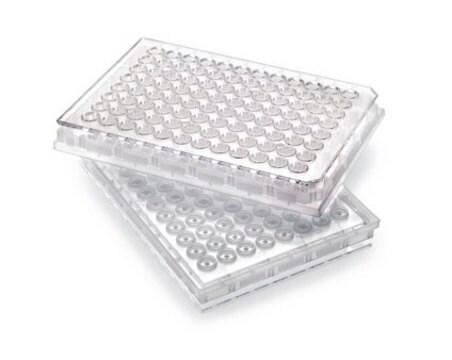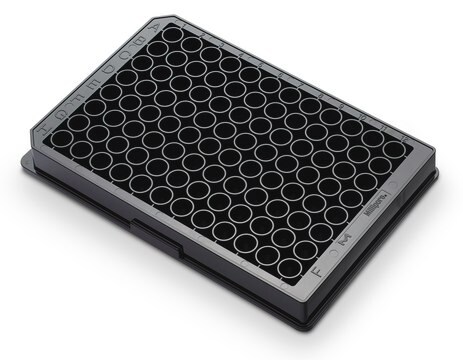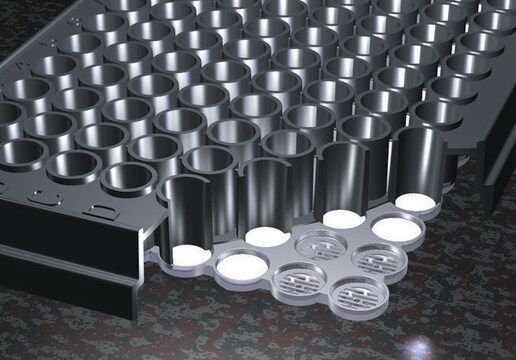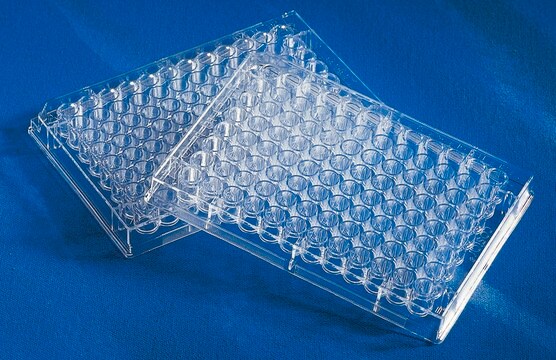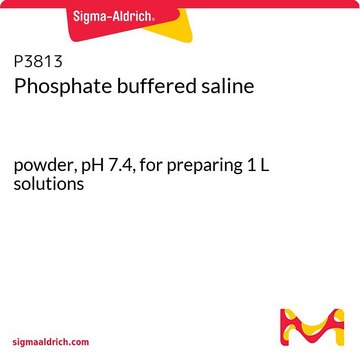MATRNPS50
96 well Collection Plate
Clear, Non-Sterile, Transport Receiver Plate, 100uL volume, 50 plates, Styrene
Synonym(s):
96-well plate, Microplate
About This Item
Recommended Products
material
polystyrene
Quality Level
sterility
non-sterile
product line
MultiScreen®
manufacturer/tradename
MultiScreen®
parameter
100 μL sample volume (per well)
technique(s)
cell culture | mammalian: suitable
parallel artificial membrane permeation assay (PAMPA): suitable
plate size
96 wells
shipped in
ambient
General description
MultiScreen-Mesh is optimized for compound and target identification in a 96-well format. The 96-well nylon mesh plate and 96-well tray fit together to provide a ready-to-use system for assays measuring paralysis, cytotoxicity, and death of multicellular organisms. Select from a range of mesh pore sizes to appropriate for your application. Simply transfer parasites, nematodes or other multicellular organisms into the wells, treat with target compound, and measure the migration of the organisms. The plates are optically clear for use with an imaging microscope or other microscopic analysis. Plates can be coated with a thin layer of agar if necessary.
MultiScreen-Mesh plates have also been shown to be useful as high throughput cell strainers prior to cellular analysis in a FACS analyzer. To dissociate clumps of cells prior to loading plate into FACS instrument, run cell suspensions through the mesh plates either by gravity flow or via gentle centrifugation.
This filter plate provides a complete system for culturing, testing and reading assay results in a one-step protocol. The system is ideal for target screening and other applications that evaluate the effect of new compounds on whole, multicellular organisms. The MultiScreen-Mesh filter plate is optimized for compound and target identification in a 96-well format. The filter plate and 96-well tray fit together to provide a ready-to-use system for assays measuring paralysis, cytotoxicity, and death of multicellular organisms. Simply transfer parasites, nematodes or other multicellular organisms into the wells, treat with target compound, and measure the migration of the organisms.
Features & Benefits:
- Multiple configurations and applications
- Chemical compatibility
- Automation-compatible
- Superior vacuum filtration and filtrate collection
- Plates are optically clear for use with an imaging microscope or other microscopic analysis
Applications
- Whole Organism Screening
Application
Cell Culture
Protein
Physical form
Other Notes
Legal Information
Certificates of Analysis (COA)
Search for Certificates of Analysis (COA) by entering the products Lot/Batch Number. Lot and Batch Numbers can be found on a product’s label following the words ‘Lot’ or ‘Batch’.
Already Own This Product?
Find documentation for the products that you have recently purchased in the Document Library.
Customers Also Viewed
Articles
This is a white paper on the Evaluation of the reproducibility of Parallel Artificial Membrane Permeation Assays (PAMPA) using MultiScreen® Filter Plates.
This is a protocol for a Membrane Integrity test for Lipid-PAMPA Artificial Membranes
This article details the benefits of combining solubility and a non-cell based permeability assay (Parallel Artificial Membrane Permeation Assay; PAMPA) into a single workflow in which a portion of the filtrate from the MultiScreen® Solubility filter plate is added to the donor compartment of the MultiScreen filter plate for the PAMPA analysis.
Protocols
Assays that predict passive absorption of orally administered drugs have become increasingly important in the drug discovery process. As previously described by Faller and Kansy such assays provide rapid, low cost and automation friendly methods to measure a compound’s passive permeability.
This page shows an example protocol of an ELISpot assay for quantifying the cells producing interferon-gamma in response to antigen or non-specific activation using phytohemagglutinin.
Our team of scientists has experience in all areas of research including Life Science, Material Science, Chemical Synthesis, Chromatography, Analytical and many others.
Contact Technical Service